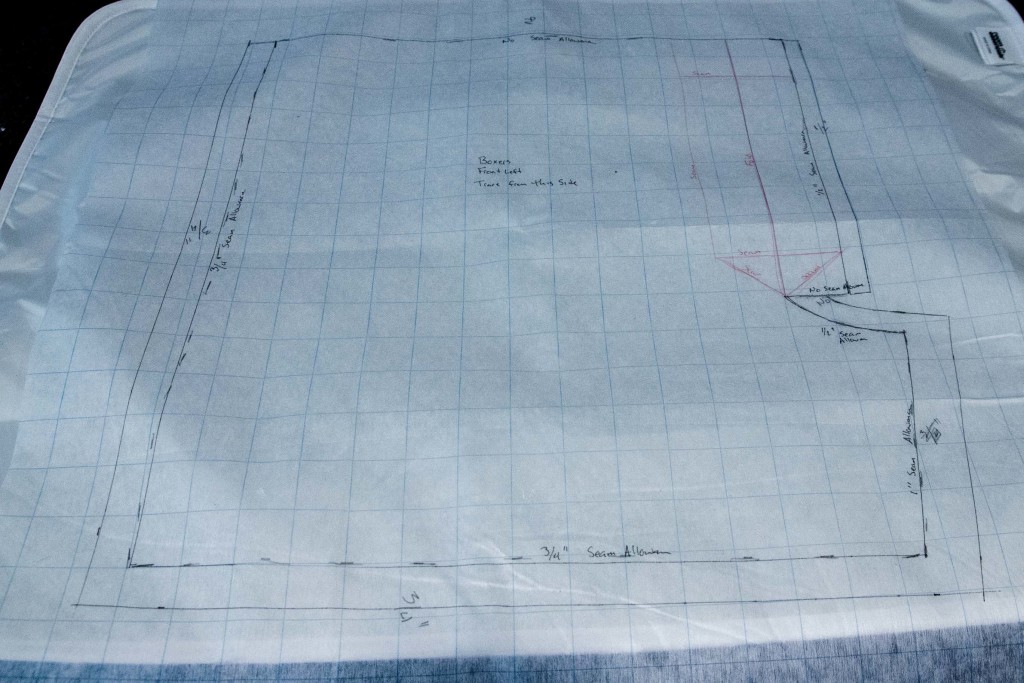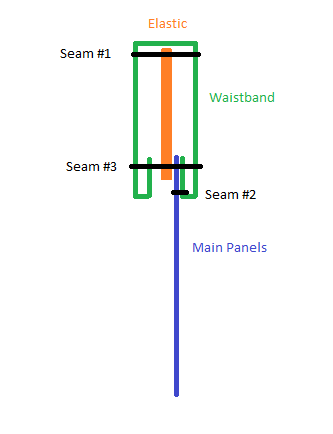I have never had any real experience sewing before, which is one of the reasons that I chose this as a project. I have replaced or moved the occasional button over the years and way back I “helped” my grandmother quilt by cutting out a couple of quilting squares. I have never done anything as involved as sewing boxers. #The_Wookie suggested I start with a simple pillow or a pillow case, since I use those everyday. By the end of this project there is a good chance that I will agree with her.
The Plan
After doing a bit of research about making clothes, especially men’s clothes, the great wisdom of the internet suggested that I start with a pair of boxers that I liked and reverse engineer them (e.g. Disassemble them and make a pattern). I am pretty sure this is not the easiest way to make boxers but I am learning a couple more skills. Here is the plan:
- Pick my favorite pair of boxers – Complete
- Disassemble them, paying attention to construction – Complete
- Create patterns based on the panels – Complete
- Cut the new fabric – Complete
- Sew the new boxers – Complete
- Repeat twice more (I figured if I have to destroy a pair, I want to make more than one) – Sort of Complete (I only did one more)
- Wear them – Complete!
Reverse Engineering Boxers
I picked out my favorite pair boxers. They are Jockey Woven Boxers (Amazon), which can be purchased for ~$16. I choose this particular pair because I really like the way they fit, but I am not a fan of the pin strip look. To help with reverse engineering I borrowed a seam ripper from #The_Wookie and started taking apart the waistband of the boxers. On these particular boxers the elastic for the waistband is completely enclosed in fabric, which is one of the reason that I like them. Determining how they accomplished this was particularly challenging. In addition, determining what type of seams they used at the various junctions is very important. For example, to create flat, comfortable junctions between the panels they used flat felled seems, which typically require special equipment to make. I did a little research and found an article on making flat felled seams without special equipment. Once, I got all of the panels apart and figured out the different types of seams used, I started to work on the patterns.

To make the patterns I purchased some pattern fabric. It is a light, woven material that has a 1 inch grid on it. After a bit of trial and error, I found that a regular pencil (not mechanical) and roller ball pens worked really well to mark the pattern fabric. At the #The_Wookies suggestion, I also picked up some tracing paper and the tracing tool. This stuff is pretty awesome, if you are old enough to remember carbon paper, it is just like that. It is used to transfer patterns from the pattern master to the fabric that you are going to use for the final garment. I started laying out the patterns, by pinning each panel to the pattern fabric, with the inside of the panel facing up. Then, I pinned the flat seams and hems, such that the seam line or hem line of the each side of panel was at the very edge of the panel. This allows me to trace the around the outside of the panel and mark the proper lines on the pattern. I started by using a pencil to mark the corners of the panel and any of the curved sections of the panel.

For the fly of the boxers there is a hem line that was not at the edge of the panel. To mark this line, I placed the tracing paper between the panel and the pattern fabric and then traced the required lines on the panel with the tracing tool. After marking all of the seam and hem lines, I removed the panel from the pattern fabric and started to mark the lines in pen. For edges that looked straight, I used a straightedge to mark the final lines and for curved edges, I carefully hand sketch over the pencil markings that I had already made. Then, using a small sewing gauge ruler I added the seam allowances to each of the seam and hem lines. Depending on where the seam was and what kind of seam it was, I added between 0.5 inches (simple hems) to 1 inch (complex flat felled seams). while I was working on the patterns for the different panels, I realized that the two of the panels where exact mirrors of each other. Since the pattern fabric that I am using is translucent, I can flip over the pattern to create a mirror of the panel. Taking advantage of this saved me some time while I was making patterns for the various panels.
The First Pair (aka Prototypes)
The next step was to cut out all of the fabric for the first pair of boxers. I am treating the first pair of boxers like a prototype: if they work out, great, if not, I am going to use the lessons learned to make the next two pairs better. I used the same tracing paper to to move the lines on the patterns on to the fabric. First, I pinned the pattern to the fabric to make sure they didn’t move relative to each other. I made sure to avoid pinning near any of the lines that I have to transfer. I placed the tracing paper between the pattern and the inside of the fabric, then ran the tracing paper tool over the lines on the pattern. The tool has a couple of different wheels on it that give different types of lines (e.g. solid, dashed, and dotted), so I used the solid lines for all of the cut lines and the dashed line for seam lines. The tracing paper is small compared to the the patterns, so you have to move it around to get all of the lines transferred.
After marking all of the fabric, I used a pair of really nice fabric shears that #The_Wookie had (I might of purchased them for her). At this point I had five pieces of fabric, 4 panels and a waist band. This is where I definitely got a little … overwhelmed. Where do you start sewing? How do you line up the seams? I need an iron? What for? I was very glad that the #The_Wookie was around to calm me down and give advice along the way. To start, I joined the two back panels together using flat felled seam. To make the seam, I followed the directions given here. Then, I created the both sided of the fly and created the button hole. A word of caution, be very careful when cutting out the inside of the buttonhole, it is very easy to cut through the end of the hole. I had to get a little creative to fix this problem, I added a decorative stitch that was very dense over the accidental cut to reinforce it.
Next, I joined the front two panels together, making sure that the fly was lined up. Up until this point, I had been trying to replicate the seam found in the original boxers. This became very difficult when jointing the fly because I am assuming when manufacturing the boxer they used fancy industrial sewing machines. I ended up with a small hole right under the fly where the two panels met. At this point I planned to come back at the end and close it up by hand. Next, I sewed the front panels to back panels on each side and on the inside of each of the legs, which resulted in something that looked like boxers without a waistband or hem seams on the legs. I tried them on and they seemed a little large, so I measured them and somehow the waist is a solid 2 inches larger than the pair that I started with. I am not quite sure how this happened, maybe I marked the seams wrong on the pattern. These are prototypes, so I can adjust the size in the next pair.

The next step was to add the waistband to the boxers. My goal was to recreate the waist band that was on the original boxers. I like it because the elastic part is completely enclosed in fabric. #The_Wookie found an article on making elastic waist band. They are making a different style waist band, but the method for lining up the elastic on fabric is still very useful. As I mentioned earlier, I spent some time reverse engineering the waistband of the original boxers so that I could recreate it on the new boxers (shown on the left). I started by making sure the waistband fabric was the same length as the waist of the completed boxer panels and then I sewed the waistband fabric into a loop. Next, I cut the elastic to a length that felt secure yet comfortable when stretched around my waist. I then pinned the elastic to the fabric waistband every 45 degrees around the waistband, ensuring: 1) that the elastic seam was in the back and 2) there was an equal amount of elastic between each pin. I then sewed “Seam #1” (in the figure to the left), stretching the elastic to the length of the fabric between each pin. This turned out to be rather difficult on my own and I ended up missing the elastic in a couple of places. Having a third (and fourth hand) helped to keep everything lined up.
After connecting the elastic to the waistband fabric, I started pinning the waistband assembly to the main panels in the same manner as I attached the elastic to the waistband fabric. The easiest way seemed to be with the boxers inside out and pinning the elastic to the outside so that you are pinning the outside of the boxers to the outside of the waistband. Then, “Seam #2” was sewn, making sure that the fabric was pulled tight between the pins. This is when I realized that the next step was going to be a doozie. I had two problems, 1) I didn’t leave enough seam allowance to easily allow for a fold and enough length to cover “Seam #2” and 2) keeping the seam allowances from “Seam #2” and the fold from the waistband in place while the pulling the elastic tight was going to be difficult. The solution I came up with was 2 fold: on this pair I was going to pin it like crazy and iron it and then pin it some more and on the next pairs I am going to allow enough fabric at the top of the patterns to create a the rolled waistband like suggested in the article linked above. For the current pair of boxers, I ended up with a couple of spots where I missed covering up the seam allowances for “Seam #2” but over all it worked out ok. All that is left is to add a button to the fly and fix a small hole that was left when combining the two front panels.
Lessons Learned:
- Change the waistband construction to a rolled waistband as discussed on this article: making elastic waist band.
- Double check the seam allowances on the patterns and seam lines, this pair was a couple of inches larger in the waist than the pair I took apart.
- Be careful cutting the buttonhole.
- Don’t accidentally throw away a piece of cut fabric.
The Second Pair (aka the Final Pair)
I will start this section with the follow apology: I forgot to take pictures while making this pair… I ended up with one in progress picture from the fabric cutting stage. Sorry.
The first thing I did was modify the patterns to account for changing the waist band and adjust the size. I added 3 inches to the top of each of the panels to allow for the rolled waistband approach (described here) and I also adjusted the seam line that runs on the hips to give the top of the boxers a little bit of a taper from the hip to the waistband. Essentially, I repeated the same steps described above to create the second pair of boxers, except this time I make the waistband differently. Changing the waistband made a huge difference, the rolled approach was much simpler. I also invested in a felting foot for #The_Wookies sewing machine. It really helped keep the flat felled seams nice and even. This pair only took me 4 hours to cut and sew, which was significantly faster than the first pair.
Conclusions
As I sit here in the completed boxers (the second pair) trying to think what conclusions I have about this project… The one though that keeps popping into my head is that I really need to order some more boxers from Amazon. I guess that is a conclusion of sorts. Here are a couple of others:
- Total Project Cost (Materials and Supplies): $70
- Total Project Time: 17 hours (at least)
- Flat felled seams are very tough to keep straight without the felling foot.
- I should remember to take more pictures!
- The rolled waistband is definitely the way to go.
Well, I am off to Amazon!
